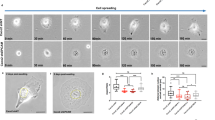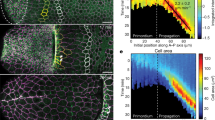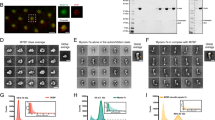Abstract
E-cadherin plays a pivotal role in epithelial morphogenesis. It controls the intercellular adhesion required for tissue cohesion and anchors the actomyosin-driven tension needed to change cell shape. In the early Drosophila embryo, Myosin-II (Myo-II) controls the planar polarized remodelling of cell junctions and tissue extension. The E-cadherin distribution is also planar polarized and complementary to the Myosin-II distribution. Here we show that E-cadherin polarity is controlled by the polarized regulation of clathrin- and dynamin-mediated endocytosis. Blocking E-cadherin endocytosis resulted in cell intercalation defects. We delineate a pathway that controls the initiation of E-cadherin endocytosis through the regulation of AP2 and clathrin coat recruitment by E-cadherin. This requires the concerted action of the formin Diaphanous (Dia) and Myosin-II. Their activity is controlled by the guanine exchange factor RhoGEF2, which is planar polarized and absent in non-intercalating regions. Finally, we provide evidence that Dia and Myo-II control the initiation of E-cadherin endocytosis by regulating the lateral clustering of E-cadherin.
This is a preview of subscription content, access via your institution
Access options
Subscribe to this journal
Receive 12 print issues and online access
$209.00 per year
only $17.42 per issue
Buy this article
- Purchase on Springer Link
- Instant access to full article PDF
Prices may be subject to local taxes which are calculated during checkout








Similar content being viewed by others
References
Yamada, S., Pokutta, S., Drees, F., Weis, W. I. & Nelson, W. J. Deconstructing the cadherin–catenin–actin complex. Cell 123, 889–901 (2005).
Gates, J. & Peifer, M. Can 1000 reviews be wrong? Actin, α-Catenin, and adherens junctions. Cell 123, 769–772 (2005).
Cavey, M. & Lecuit, T. Molecular bases of cell–cell junctions stability and dynamics. Cold Spring Harb. Perspect. Biol. 1, a002998 (2009).
Nishimura, T. & Takeichi, M. Remodelling of the adherens junctions during morphogenesis. Curr. Top. Dev. Biol. 89, 33–54 (2009).
Lecuit, T. & Lenne, P. F. Cell surface mechanics and the control of cell shape, tissue patterns and morphogenesis. Nat. Rev. Mol. Cell Biol. 8, 633–644 (2007).
Quintin, S., Gally, C. & Labouesse, M. Epithelial morphogenesis in embryos: asymmetries, motors and brakes. Trends Genet. 24, 221–230 (2008).
Classen, A. K., Anderson, K. I., Marois, E. & Eaton, S. Hexagonal packing of Drosophila wing epithelial cells by the planar cell polarity pathway. Dev. Cell 9, 805–817 (2005).
Farhadifar, R., Roper, J. C., Aigouy, B., Eaton, S. & Julicher, F. The influence of cell mechanics, cell–cell interactions, and proliferation on epithelial packing. Curr. Biol. 17, 2095–2104 (2007).
Thiery, J. P., Acloque, H., Huang, R. Y. & Nieto, M. A. Epithelial–mesenchymal transitions in development and disease. Cell 139, 871–890 (2009).
Dawes-Hoang, R. E. et al. Folded gastrulation, cell shape change and the control of myosin localization. Development 132, 4165–4178 (2005).
Kolsch, V., Seher, T., Fernandez-Ballester, G. J., Serrano, L. & Leptin, M. Control of Drosophila gastrulation by apical localization of adherens junctions and RhoGEF2. Science 315, 384–386 (2007).
Martin, A. C., Kaschube, M. & Wieschaus, E. F. Pulsed contractions of an actin–myosin network drive apical constriction. Nature 457, 495–499 (2009).
Bertet, C., Sulak, L. & Lecuit, T. Myosin-dependent junction remodelling controls planar cell intercalation and axis elongation. Nature 429, 667–671 (2004).
Blankenship, J. T., Backovic, S. T., Sanny, J. S., Weitz, O. & Zallen, J. A. Multicellular rosette formation links planar cell polarity to tissue morphogenesis. Dev. Cell 11, 459–470 (2006).
Cavey, M., Rauzi, M., Lenne, P. F. & Lecuit, T. A two-tiered mechanism for stabilization and immobilization of E-cadherin. Nature 453, 751–756 (2008).
Rauzi, M., Verant, P., Lecuit, T. & Lenne, P. F. Nature and anisotropy of cortical forces orienting Drosophila tissue morphogenesis. Nat. Cell Biol. 10, 1401–1410 (2008).
Fernandez-Gonzalez, R., Simoes Sde, M., Roper, J. C., Eaton, S. & Zallen, J. A. Myosin II dynamics are regulated by tension in intercalating cells. Dev. Cell 17, 736–743 (2009).
Rauzi, M., Lenne, P. F. & Lecuit, T. Planar polarized actomyosin contractile flows control epithelial junction remodelling. Nature 468, 1110–1114 (2010).
Irvine, K. D. & Wieschaus, E. Cell intercalation during Drosophila germband extension and its regulation by pair-rule segmentation genes. Development 120, 827–841 (1994).
Simoes Sde, M. et al. Rho-kinase directs Bazooka/Par-3 planar polarity during Drosophila axis elongation. Dev. Cell 19, 377–388 (2010).
Perrais, D. & Merrifield, C. J. Dynamics of endocytic vesicle creation. Dev. Cell 9, 581–592 (2005).
Kaksonen, M., Toret, C. P. & Drubin, D. G. Harnessing actin dynamics for clathrin-mediated endocytosis. Nat. Rev. Mol. Cell Biol. 7, 404–414 (2006).
Georgiou, M., Marinari, E., Burden, J. & Baum, B. Cdc42, Par6, and aPKC regulate Arp2/3-mediated endocytosis to control local adherens junction stability. Curr. Biol. 18, 1631–1638 (2008).
Harris, K. P. & Tepass, U. Cdc42 and Par proteins stabilize dynamic adherens junctions in the Drosophila neuroectoderm through regulation of apical endocytosis. J. Cell Biol. 183, 1129–1143 (2008).
Leibfried, A., Fricke, R., Morgan, M. J., Bogdan, S. & Bellaiche, Y. Drosophila Cip4 and WASp define a branch of the Cdc42-Par6-aPKC pathway regulating E-cadherin endocytosis. Curr. Biol. 18, 1639–1648 (2008).
Afshar, K., Stuart, B. & Wasserman, S. A. Functional analysis of the Drosophila diaphanous FH protein in early embryonic development. Development 127, 1887–1897 (2000).
Barrett, K., Leptin, M. & Settleman, J. The Rho GTPase and a putative RhoGEF mediate a signalling pathway for the cell shape changes in Drosophila gastrulation. Cell 91, 905–915 (1997).
Grosshans, J. et al. RhoGEF2 and the formin Dia control the formation of the furrow canal by directed actin assembly during Drosophila cellularisation. Development 132, 1009–1020 (2005).
Hacker, U. & Perrimon, N. DRhoGEF2 encodes a member of the Dbl family of oncogenes and controls cell shape changes during gastrulation in Drosophila. Genes Dev. 12, 274–284 (1998).
Palacios, F., Tushir, J. S., Fujita, Y. & D’Souza-Schorey, C. Lysosomal targeting of E-cadherin: a unique mechanism for the down-regulation of cell–cell adhesion during epithelial to mesenchymal transitions. Mol. Cell Biol. 25, 389–402 (2005).
Troyanovsky, R. B., Sokolov, E. P. & Troyanovsky, S. M. Endocytosis of cadherin from intracellular junctions is the driving force for cadherin adhesive dimer disassembly. Mol. Biol. Cell 17, 3484–3493 (2006).
Gonzalez-Gaitan, M. & Jackle, H. Role of Drosophila α -adaptin in presynaptic vesicle recycling. Cell 88, 767–776 (1997).
Sorkin, A. Cargo recognition during clathrin-mediated endocytosis: a team effort. Curr. Opin. Cell Biol. 16, 392–399 (2004).
Sever, S. Dynamin and endocytosis. Curr. Opin. Cell Biol. 14, 463–467 (2002).
Pilot, F., Philippe, J. M., Lemmers, C. & Lecuit, T. Spatial control of actin organization at adherens junctions by a synaptotagmin-like protein Btsz. Nature 442, 580–584 (2006).
Harris, T. J. & Peifer, M. Adherens junction-dependent and -independent steps in the establishment of epithelial cell polarity in Drosophila. J. Cell Biol. 167, 135–147 (2004).
Sapir, A., Schweitzer, R. & Shilo, B. Z. Sequential activation of the EGF receptor pathway during Drosophila oogenesis establishes the dorsoventral axis. Development 125, 191–200 (1998).
Jekely, G., Sung, H. H., Luque, C. M. & Rorth, P. Regulators of endocytosis maintain localized receptor tyrosine kinase signalling in guided migration. Dev. Cell 9, 197–207 (2005).
Wang, L. H., Rothberg, K. G. & Anderson, R. G. Mis-assembly of clathrin lattices on endosomes reveals a regulatory switch for coated pit formation. J. Cell Biol. 123, 1107–1117 (1993).
Blanchard, E. et al. Hepatitis C virus entry depends on clathrin-mediated endocytosis. J. Virol. 80, 6964–6972 (2006).
Kanerva, A. et al. Chlorpromazine and apigenin reduce adenovirus replication and decrease replication associated toxicity. J. Gene Med. 9, 3–9 (2007).
Kasprowicz, J. et al. Inactivation of clathrin heavy chain inhibits synaptic recycling but allows bulk membrane uptake. J. Cell Biol. 182, 1007–1016 (2008).
Yonemura, S., Wada, Y., Watanabe, T., Nagafuchi, A. & Shibata, M. α-catenin as a tension transducer that induces adherens junction development. Nat. Cell Biol. 12, 533–542 (2010).
Lanzetti, L. Actin in membrane trafficking. Curr. Opin. Cell Biol. 19, 453–458 (2007).
Roux, A., Uyhazi, K., Frost, A. & De Camilli, P. GTP-dependent twisting of dynamin implicates constriction and tension in membrane fission. Nature 441, 528–531 (2006).
Bertet, C., Rauzi, M. & Lecuit, T. Repression of Wasp by JAK/STAT signalling inhibits medial actomyosin network assembly and apical cell constriction in intercalating epithelial cells. Development 136, 4199–4212 (2009).
Romero, S. et al. Formin is a processive motor that requires profilin to accelerate actin assembly and associated ATP hydrolysis. Cell 119, 419–429 (2004).
Homem, C. C. & Peifer, M. Diaphanous regulates myosin and adherens junctions to control cell contractility and protrusive behaviour during morphogenesis. Development 135, 1005–1018 (2008).
Pellegrin, S. & Mellor, H. Actin stress fibres. J. Cell Sci. 120, 3491–3499 (2007).
Nakayama, M. et al. Rho-kinase phosphorylates PAR-3 and disrupts PAR complex formation. Dev. Cell 14, 205–215 (2008).
Winter, C. G. et al. Drosophila Rho-associated kinase (Drok) links Frizzled-mediated planar cell polarity signalling to the actin cytoskeleton. Cell 105, 81–91 (2001).
Watanabe, N. et al. p140mDia, a mammalian homolog of Drosophila diaphanous, is a target protein for Rho small GTPase and is a ligand for profilin. EMBO J. 16, 3044–3056 (1997).
Alberts, A. S. Identification of a carboxyl-terminal diaphanous-related formin homology protein autoregulatory domain. J. Biol. Chem. 276, 2824–2830 (2001).
Nikolaidou, K. K. & Barrett, K. A Rho GTPase signalling pathway is used reiteratively in epithelial folding and potentially selects the outcome of Rho activation. Curr. Biol. 14, 1822–1826 (2004).
Padash Barmchi, M., Rogers, S. & Hacker, U. DRhoGEF2 regulates actin organization and contractility in the Drosophila blastoderm embryo. J. Cell Biol. 168, 575–585 (2005).
Mulinari, S., Barmchi, M. P. & Hacker, U. DRhoGEF2 and diaphanous regulate contractile force during segmental groove morphogenesis in the Drosophila embryo. Mol. Biol. Cell 19, 1883–1892 (2008).
Murphy, A. M. & Montell, D. J. Cell type-specific roles for Cdc42, Rac, and RhoL in Drosophila oogenesis. J. Cell Biol. 133, 617–630 (1996).
Magie, C. R., Meyer, M. R., Gorsuch, M. S. & Parkhurst, S. M. Mutations in the Rho1 small GTPase disrupt morphogenesis and segmentation during early Drosophila development. Development 126, 5353–5364 (1999).
Tkachenko, E., Lutgens, E., Stan, R. V. & Simons, M. Fibroblast growth factor 2 endocytosis in endothelial cells proceed via syndecan-4-dependent activation of Rac1 and a Cdc42-dependent macropinocytic pathway. J. Cell Sci. 117, 3189–3199 (2004).
Schneider, A. et al. Flotillin-dependent clustering of the amyloid precursor protein regulates its endocytosis and amyloidogenic processing in neurons. J. Neurosci. 28, 2874–2882 (2008).
Collins, R. F. et al. Uptake of oxidized low density lipoprotein by CD36 occurs by an actin-dependent pathway distinct from macropinocytosis. J. Biol. Chem. 284, 30288–30297 (2009).
Ledbetter, J. A., June, C. H., Grosmaire, L. S. & Rabinovitch, P. S. Crosslinking of surface antigens causes mobilization of intracellular ionized calcium in T lymphocytes. Proc. Natl Acad. Sci. USA 84, 1384–1388 (1987).
Miyamoto, S., Akiyama, S. K. & Yamada, K. M. Synergistic roles for receptor occupancy and aggregation in integrin transmembrane function. Science 267, 883–885 (1995).
Levenberg, S., Katz, B. Z., Yamada, K. M. & Geiger, B. Long-range and selective autoregulation of cell–cell or cell–matrix adhesions by cadherin or integrin ligands. J. Cell Sci. 111 (Pt 3), 347–357 (1998).
Garcia-Garcia, E. & Rosales, C. Signal transduction during Fc receptor-mediated phagocytosis. J. Leukoc. Biol. 72, 1092–1108 (2002).
Goswami, D. et al. Nanoclusters of GPI-anchored proteins are formed by cortical actin-driven activity. Cell 135, 1085–1097 (2008).
Mostowy, S. & Cossart, P. Cytoskeleton rearrangements during Listeria infection: clathrin and septins as new players in the game. Cell. Motil. Cytoskeleton 66, 816–823 (2009).
Fujita, Y. et al. Hakai, a c-Cbl-like protein, ubiquitinates and induces endocytosis of the E-cadherin complex. Nat. Cell Biol. 4, 222–231 (2002).
Acknowledgements
We are grateful to all of those who generously provided us with reagents, especially H. Chang, M. Freeman, M. Gonzalez-Gaitan, J. Grosshans, U. Häcker, R. Karess, D. Kiehart, K. Klaembt, A. C. Martin, E. Wieschaus, H. Oda, M. Peifer, P. Rørth, E. Schejter, A. Schmidt, R. Vincentelli and the Bloomington stock centre. We thank the members of the Lecuit laboratory for fruitful discussions and for useful comments on the manuscript, especially S. Kerridge and J-M. Philippe. This work was supported by the CNRS, the Association pour la Recherche sur le Cancer (ARC) and the Fondation pour la Recherche Médicale (équipe labellisée). A.P. was supported by a fellowship from ARC.
Author information
Authors and Affiliations
Contributions
The experiments were conceived and planned by R.L., A.P. and T.L. A.P. made the initial observations that AP2 and Dyn were enriched at adherens junctions in early embryos, carried out the electron microscopy experiments (Fig. 1a–c) and showed that shi-ts is required for cell intercalation and GBE (Fig. 3a–g,g′). R. Levayer carried out all the other experiments. The data were analysed by R.L., A.P. and T.L. The manuscript was written by R.L. and T.L.
Corresponding author
Ethics declarations
Competing interests
The authors declare no competing financial interests.
Supplementary information
Supplementary Information
Supplementary Information (PDF 2022 kb)
Supplementary Movie 1
Supplementary Information (MOV 2628 kb)
Supplementary Movie 2
Supplementary Information (MOV 2617 kb)
Supplementary Movie 3
Supplementary Information (MOV 1689 kb)
Supplementary Movie 4
Supplementary Information (MOV 2808 kb)
Supplementary Movie 5
Supplementary Information (MOV 2761 kb)
Supplementary Movie 6
Supplementary Information (MOV 3194 kb)
Supplementary Movie 7
Supplementary Information (MOV 1955 kb)
Supplementary Movie 8
Supplementary Information (MOV 3788 kb)
Supplementary Movie 9
Supplementary Information (MOV 5286 kb)
Supplementary Movie 10
Supplementary Information (MOV 3462 kb)
Supplementary Movie 11
Supplementary Information (MOV 1840 kb)
Supplementary Movie 12
Supplementary Information (MOV 3222 kb)
Supplementary Movie 13
Supplementary Information (MOV 1746 kb)
Supplementary Movie 14
Supplementary Information (MOV 4252 kb)
Supplementary Movie 15
Supplementary Information (MOV 2966 kb)
Supplementary Movie 16
Supplementary Information (MOV 2802 kb)
Supplementary Movie 17
Supplementary Information (MOV 2578 kb)
Supplementary Movie 18
Supplementary Information (MOV 2975 kb)
Rights and permissions
About this article
Cite this article
Levayer, R., Pelissier-Monier, A. & Lecuit, T. Spatial regulation of Dia and Myosin-II by RhoGEF2 controls initiation of E-cadherin endocytosis during epithelial morphogenesis. Nat Cell Biol 13, 529–540 (2011). https://doi.org/10.1038/ncb2224
Received:
Accepted:
Published:
Issue Date:
DOI: https://doi.org/10.1038/ncb2224
This article is cited by
-
Patterning and dynamics of membrane adhesion under hydraulic stress
Nature Communications (2023)
-
Cellular dynamics of EMT: lessons from live in vivo imaging of embryonic development
Cell Communication and Signaling (2021)
-
Tissue fluidity mediated by adherens junction dynamics promotes planar cell polarity-driven ommatidial rotation
Nature Communications (2021)
-
Role of Actin Cytoskeleton in E-cadherin-Based Cell–Cell Adhesion Assembly and Maintenance
Journal of the Indian Institute of Science (2021)
-
Cell-matrix adhesion and cell-cell adhesion differentially control basal myosin oscillation and Drosophila egg chamber elongation
Nature Communications (2017)



